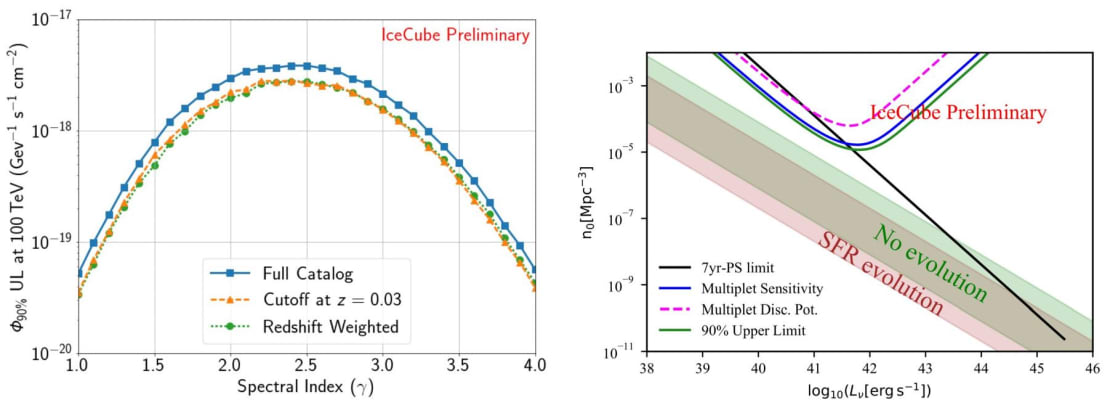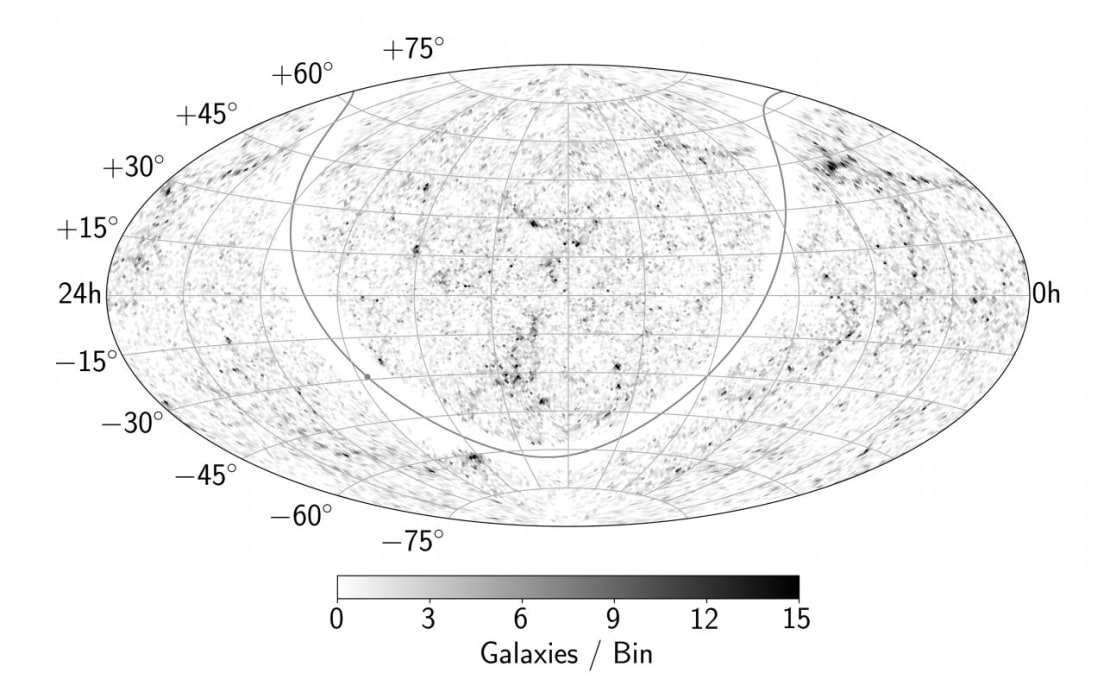What does “local” mean to you? Maybe your local coffee shop is around the corner from your office. Maybe your local pharmacy is a 15-minute walk from your home. But on the scale of the cosmos, the definition of local is stretched, to say the least. In fact, the “local universe” is defined as the volume of space surrounding the Milky Way in which most galaxies are visible to our telescopes—extending up to 300 million light-years away from us.
When it comes to analyses done by the IceCube Collaboration, this is local indeed. After all, the IceCube Neutrino Observatory detected an astrophysical neutrino—a high-energy particle from outer space—from a flaring blazar approximately 5 billion light-years away. That source, called TXS 0506+056, is still the only confirmed source of astrophysical neutrinos, but it certainly does not explain all of the astrophysical neutrinos we see.
IceCube has not yet found neutrino sources within our galaxy, but there may be sources that are not too much farther out. To test this possibility, the IceCube Collaboration recently performed an analysis scouring the local universe for potential neutrino sources. They conducted two different searches that looked for correlations between neutrino emission and dense regions in a catalog of galaxies called the 2MASS Redshift Survey (2MRS). While they did not find significant sources, they were able to put constraints on neutrino emission from nearby galaxies, which they present in a paper recently submitted to the Journal of Cosmology and Astroparticle Physics.

Neutrinos are tricky. They are fundamental particles but have no charge and interact very weakly, which means they can fly through light-years of matter without giving any hint that they have passed. The IceCube Neutrino Observatory was built to try and “catch” them. Embedded in the South Pole ice are over 5,000 optical modules that will light up when triggered by a flash of radiation caused by a neutrino interacting with the ice. If the neutrino interacts and produces a particle called a muon, that muon may trigger multiple optical modules, leaving a trail of signals that scientists can trace toward the neutrino’s source—whatever that is.
While IceCube analyses typically focus on looking to see if neutrinos originate from a few bright, intense, and faraway objects (like blazars), some researchers decided to look at the local universe, including Steve Sclafani of Drexel University in Philadelphia, PA. “We have one advantage when focused on the local universe: At the closest distances, large-scale structures—like superclusters, the supergalactic plane, filamentary structure, and local voids—exist,” he says.
This paper describes two analyses that searched for excess neutrinos correlated with local large-scale structures. Each search tested a different hypothesis about how the neutrinos were emitted. The “template analysis” created an all-sky template of the local galaxy density to test whether the matter of the local universe was acting as a target, where ultra-high-energy cosmic rays would interact and produce neutrinos. The “multiplet analysis” tested the hypothesis that clusters of neutrinos called “multiplets” are generated by neutrino sources within the local universe.
“The motivation for this analysis is rather simple: After 10 years of detecting astrophysical neutrinos, we would like to figure out their origin,” says Étienne Bourbeau of the Niels Bohr Institute in Copenhagen, Denmark, who led the multiplet search.
The simplest explanation, he says, is that neutrinos are produced by astronomical objects made up of normal matter. “If that’s true, then you would expect neutrinos to come from the places in the sky where there is the most stuff,” he says.
To find where the most “stuff” is in the universe, researchers can use catalogs of galaxies established by other astronomical observatories—here, the 2MRS survey. Their goal was to see whether neutrinos detected by IceCube correlated with our best estimate of matter density in the local universe. Galaxies are not uniformly distributed in our local universe, so if neutrinos really do come from the galaxies mapped by 2MRS, there should be more neutrino clusters from specific regions in the sky.
First, they defined the IceCube neutrino emission using an existing IceCube analysis, the seven-year point source search.

For the template analysis, Sclafani and his collaborators took the 2MRS infrared catalog, weighted each galaxy, and created a template of the sky. Next, they looked for any correlation between our neutrino sky and the 2MRS sky—in other words, a correlation between neutrino emission and the large-scale features.
Meanwhile, for the multiplet analysis, Bourbeau and his collaborators used 2MRS in a slightly different way. They tested whether the incidence of neutrino clusters in IceCube correlates significantly with the density of galaxies observed in the 2MRS catalog. They used a previously published analysis of neutrino clustering from the seven-year sample, then compared the distribution of these clusters to 10,000 random distributions of the same number of multiplets.

Ultimately, neither analysis found any significant correlation between astrophysical neutrinos or multiplets and the galaxies of the 2MRS catalog. Based on that, however, the researchers were able to put boundaries on the density and average luminosity of any hypothetical population of neutrino sources located within our local universe.
“Although this work didn’t turn anything up, it established methods for this kind of search, and as new all-sky surveys arrive we can revisit this analysis and see if we are able to detect local galaxy neutrinos,” says Sclafani. “Even though we have one source, there is still a push to explain where all our astrophysical neutrinos are coming from.”
Of course, Bourbeau points out, it could be possible that neutrino sources are much farther out in space. After all, TXS 0506+056 is 5 billion light-years away. Wherever the sources are, IceCube will keep looking.
info “Constraints on Neutrino Emission from Nearby Galaxies Using the 2MASS Redshift Survey and IceCube,” IceCube Collaboration: M. G. Aartsen et al., JCAP 07 (2020) 042, iopscience.iop.org, arxiv.org/abs/1911.11809